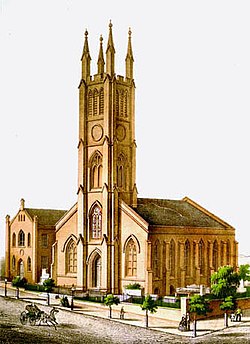Westminster Hall and Burying Ground
|
Westminster Presbyterian Church and Cemetery
|
|

Westminster Presbyterian Church, (Baltimore, Maryland) depicted in a postcard, ca. 1857
|
|
| Location | 509 West Fayette Street at North Greene Street, Baltimore, Maryland |
|---|---|
| Coordinates | 39°17′24″N 76°37′26″W / 39.29000°N 76.62389°WCoordinates: 39°17′24″N 76°37′26″W / 39.29000°N 76.62389°W |
| Area | 1 acre (0.40 ha) |
| Built | 1815 |
| Architect | Godefroy, Maximilien; Et al. |
| Architectural style | Greek Revival, Exotic Revival, Gothic Revival |
| NRHP Reference # | 74002218 |
| Added to NRHP | September 17, 1974 |
Westminster Hall and Burying Ground is a graveyard and former church located at 519 West Fayette Street (at North Greene Street) in Baltimore, Maryland, United States. Occupying the southeast corner of West Fayette and North Greene Street on the west side of downtown Baltimore, the site is probably most famous as the burial site of Edgar Allan Poe, (1809–1849). The complex was declared a national historic district in 1974.
The graveyard was established in January 1787 by the First Presbyterian Church of Baltimore, from land on the westside of old Baltimore Town purchased by a committee of noted laymen consisting of William Smith, John Boyd, and William Patterson (locally prominent merchant, civic activist, owner of future Patterson Park, and father of noted Baltimore socialite/debutante Elizabeth ("Betsy") Patterson, (1785-1879), who married Jerome Bonaparte in 1803, brother of the French Emperor Napoleon I) from Col. John Eager Howard, (1752-1827), former commander of the famous "Maryland Line" regiment of the Continental Army in the American Revolution. Col. Howard owned the estate and mansion of "Belvidere", in what was called "Howard's Woods", north of Baltimore Town (later to become the neighborhood of Mount Vernon-Belvedere, and the site of the landmark Washington Monument). First Presbyterian, a congregation of socially and economically elite local Presbyterians and Reformed Protestants, then was located in downtown Baltimore since its founding in 1761 at the northwest corner of East Fayette Street at North Street (later Guilford Avenue) in a landmark twin-spired Georgian architecture-Federal style architecture structure from 1790-1795. Over the next 60 years, the "Burying Grounds" (or cemetery) became the final resting place for many important and influential merchants, politicians, statesmen, and dozens of veterans (officers and soldiers) of the American Revolutionary War and War of 1812 who were citizens of the burgeoning and soon-to-be, the third largest city in America - Baltimore.
...
Wikipedia



